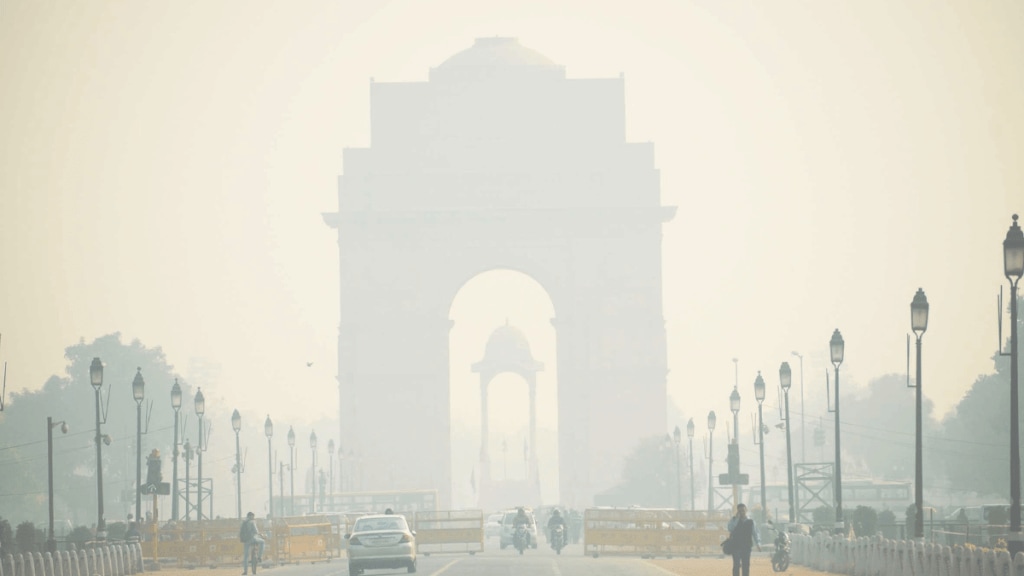Delhi continues to grapple with alarming levels of air pollution, as the average Air Quality Index (AQI) remained in the ‘severe’ category on Wednesday morning. The Capital woke up to a thick blanket of smog, reducing visibility and raising health concerns for residents.
Current Air Quality and Visibility
At 7 am, Delhi’s average AQI stood at 423, with the most polluted areas being Mundka (464), followed by Wazirpur and Alipur (462). The dense smog also affected visibility, with only 800 meters recorded at the Indira Gandhi International Airport. The India Meteorological Department (IMD) predicted that smog or shallow fog conditions would persist throughout the day, further exacerbating the city’s pollution crisis.
Measures Under GRAP Stage IV
In response to the deteriorating air quality, the Commission for Air Quality Management (CAQM) has implemented Stage IV of the Graded Response Action Plan (GRAP), a set of emergency measures designed to curb pollution in the Delhi-NCR region. GRAP, approved by the Supreme Court in 2016, is activated when air quality reaches critical thresholds.
Key Rules Under GRAP Stage IV
- Restriction on Trucks
- Entry of truck traffic into Delhi is banned, except for those carrying essential commodities or providing essential services.
- Only LNG/CNG/Electric/BS-VI Diesel trucks are permitted to enter Delhi.
- Light Commercial Vehicles (LCVs)
- LCVs registered outside Delhi, except those running on EVs, CNG, or BS-VI Diesel, are prohibited from entering unless transporting essential goods.
- Ban on Older Vehicles
- A strict prohibition is enforced on Delhi-registered BS-IV and below diesel-operated Medium Goods Vehicles (MGVs) and Heavy Goods Vehicles (HGVs), except for essential services.
- Construction and Demolition Ban
- All construction and demolition activities, including linear public projects such as highways, roads, and power transmission infrastructure, are halted.
- Educational and Work Adjustments
- NCR and Delhi governments may decide to discontinue physical classes for students in grades VI-IX and XI, shifting to online lessons.
- Public and private offices may operate at 50% capacity, encouraging work-from-home arrangements.
- Additional Emergency Measures
- Potential closures of non-emergency commercial activities.
- Implementation of the odd-even rule for vehicular movement based on registration numbers.
Despite the emergency measures, Delhi faces persistent challenges in tackling air pollution. Vehicular emissions, industrial pollutants, construction dust, and seasonal stubble burning in neighbouring states contribute significantly to the city’s toxic air.
Steps Needed for Sustainable Improvement
- Adoption of Cleaner Fuels: Expanding the use of CNG, EVs, and BS-VI standards for all vehicles.
- Improved Public Transportation: Increasing metro and electric bus fleets to reduce reliance on private vehicles.
- Industrial Regulations: Strict monitoring of emissions from factories and power plants.
- Green Initiatives: Boosting urban green cover and implementing better waste management practices.
Health Impacts and Public Advisory
The severe AQI levels pose serious health risks, particularly for children, the elderly, and individuals with pre-existing respiratory or cardiac conditions. Residents are advised to:
- Limit outdoor activities, especially during early mornings and evenings.
- Use N95 masks when stepping out.
- Employ air purifiers indoors to reduce exposure to pollutants.
A combination of stubble burning, local pollution sources, and adverse weather conditions contributed to the alarming levels of air pollution. Stubble burning accounted for 19.18% of emissions, while low wind speeds, dense fog, and falling temperatures trapped pollutants, allowing secondary pollutants to form.
Local sources, including vehicular emissions, industrial pollution, open burning, and dust, contribute significantly to Delhi’s pollution levels year-round. However, the influx of smoke from farm fires and unfavourable weather exacerbates the situation during winter. On Monday, 15 of the city’s 40 air quality monitoring stations registered the maximum AQI of 500.
Tuesday offered little respite, with Delhi’s AQI remaining in the “severe plus” category at 460. Out of 32 air monitoring stations, 23 recorded AQI levels above 450. These alarming figures underscore the pressing need for robust measures to combat pollution, including stricter regulation of emissions and accelerated efforts to address stubble burning and industrial emissions. Without decisive action, Delhi’s residents face escalating health risks from prolonged exposure to toxic air.
Delhi’s air pollution crisis underscores the urgency for coordinated efforts from governments, industries, and citizens. While GRAP offers temporary relief, sustained policy interventions and behavioural changes are essential to ensure breathable air for the Capital’s millions.

